
On Saturday 10 April 2010 the third "trial run" of the newly-completed Cape Town stadium was held. This was the last trial before the stadium was handed over to FIFA for the 2010 World Cup Finals, and included the use of the floodlights and full spectator capacity (up to 68 000 people). The entire public transport system was also to be put to the test. Two matches were scheduled, both under-20 football internationals - South Africa vs Nigeria at 4:30 PM and Brazil vs Ghana at 7 PM.
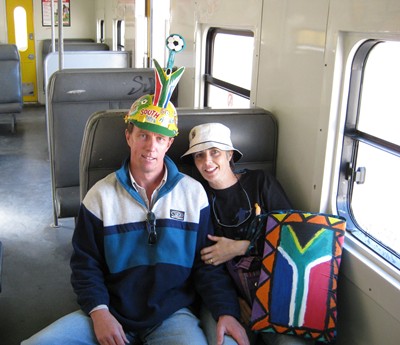
Four of us from the southern suburbs of Cape Town decided to go to this event and see how smoothly (or otherwise) everything functioned. On Friday afternoon I called Cape Town Metropolitan Transport Information via their toll-free number (0800 656463) and was informed by a cheerful girl that late trains would be operating on Saturday night, with the last train from Cape Town to Fish Hoek at 22:30. The second football match was due to finish at about 9 PM, so that seemed more than adequate. In fact, four late trains were scheduled on the Southern Suburbs line on Saturday between 21:10 and 22:30 ; there were notices on display at various stations advertising these trains and showing their times.
Heavy seas in December 2009 had unfortunately caused extensive damage to the railway retaining wall near Glencairn (north of Simon's Town), resulting in the section of track between Fish Hoek and Simon's Town being closed since then pending costly repairs. The rail schedule has remained unchanged however - passengers were (and still are) conveyed by bus between Fish Hoek and Simon's Town. Trains that used to originate in Simon's Town now start at Fish Hoek, but have to wait for the bus from Simon's Town to arrive before departing. Because the bus trip frequently takes longer than the train would have done, these trains are often delayed. Passengers also have to get off the Simon's Town bus, go through security at Fish Hoek station and (sometimes) cross the tracks via a subway before boarding the train, resulting in further delays.
And so it proved for us on Saturday afternoon 10 April. MetroRail train number 0148, scheduled to depart Fish Hoek at 14:10, only left at about 14:20 due to the late arrival of the Simon's Town bus. There were a number of football supporters on the train (one of the older yellow-liveried 5M2A models) and by the time we pulled into Cape Town at about 15:15 the train was quite full.
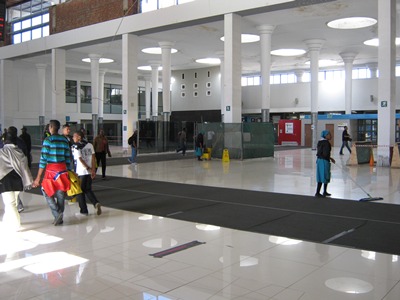
Cape Town station, occupying pride of place in the city centre along Adderley Street, is being renovated and improved for the World Cup. The work is still incomplete, so there are barriers and scaffolding in places, but the initial impression is extremely favourable. The old dark and shabby interior is gone - the station is now light, airy and spacious, with gleaming tiles and natural light flooding through tall windows. The cramped and uncomfortable ticket offices that were in the middle of the concourse have been relocated and made far more passenger-friendly.
We debated walking from the station through Cape Town's city centre to the stadium, a distance of about two kilometres. However, shuttle buses were advertised (free with a valid match ticket) so we decided to forego the walk and continue our informal public transport investigation. A short stroll north-east from the station past the Civic Centre brought us to Hertzog Boulevard, one of the main routes into the city from the southern suburbs, where thousands of good-natured soccer spectators were converging in droves. Hertzog Boulevard will in future be the location of the main city centre station in Cape Town's new Integrated Rapid Transport (IRT) bus system, visibly under construction all over greater Cape Town. Although there were crowds of people, there were also many buses lined up at the kerb with marshalls directing people on to them, so we didn't have to wait long before we boarded and headed off. Interestingly, all of the buses were branded "Golden Arrow", the name of a privately-owned bus company in Cape Town. Clearly the IRT vehicles were not yet in service and Golden Arrow had been commissioned to supply buses for this trial event.
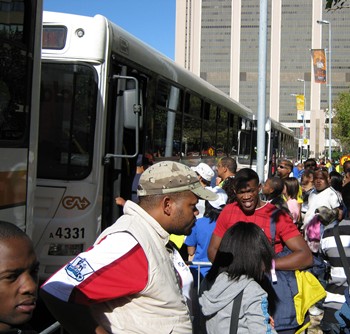
After swinging through the city centre to Green Point the bus stopped on Western Boulevard, next to Somerset Road and near the new stadium. The Green Point IRT bus station was nearby but clearly still under construction and not yet ready for use. We disembarked and joined a throng of people strolling down the "fan walk" alongside Somerset Road - this is a specially-constructed pedestrian walkway leading from Cape Town's city centre to the new stadium. The walkway has been brick-paved and attractively landscaped.
The old traffic circle in Green Point has been raised to allow the walkway to pass underneath it, thus ensuring that pedestrians can access the stadium without crossing any roads at all. No dark and dimly-lit subways here - the pedestrian underpass is open and spacious. There is pedestrian access to the new stadium from all directions - the city, the V&A Waterfront, Green Point and Sea Point. From being completely pedestrian-unfriendly, Green Point and the area around the stadium has been transformed into a place that now welcomes people on foot. For years Cape Town has progressively become more car-friendly and more difficult for pedestrians, so it was pleasure to see that this unfortunate and short-sighted trend is at last being reversed.
Entering the stadium itself involved two security checks. First we had to go through barriers where we were scanned airport-style for weapons and food. No food or drink is allowed into the stadium, which seems draconian and unnecessary, and resulted in many people (including us) sitting around outside the barriers hurriedly cramming sandwiches, fruit, chips and softdrinks into their mouths. Suitably fed and empty-handed, we approached the security barriers again and this time succeeded in gaining entry to the outer precints of the stadium. Further on another barrier awaited us, this time the ticketing check. It was easy and quick - you scan your bar-coded ticket at a special reader and a turnstile opens to let you through, in very similar fashion to entering a station on the London Underground.
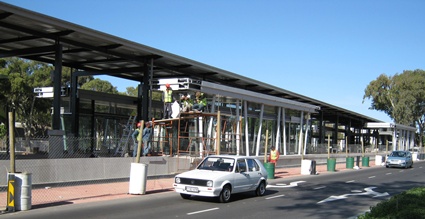
A long, gradually-stepped slope led up to the stadium itself, an immense egg-shaped structure that dominates the Green Point skyline. Inside, the stadium is open and spacious, with wide walkways and excellent signage. We found our seats easily enough and sat down just before the start of the first match, which proved disappointing because South Africa lost 3-1 to Nigeria after being 1-0 up and seemingly in a dominant position.
The pitch itself is quite wide, with grass extending for some distance beyond each touchline and behind the goalposts ; despite this we always felt quite close to the action. Security guards were stationed around the entire perimeter of the pitch, facing outwards and alert for any signs of crowd trouble or a pitch invasion (there wasn't any). Thankfully the stadium has not had to resort to the kind of security fencing that is prevalent at football stadiums in some parts of Europe, where matches are virtually played behind bars. Contrary to a belief that is fashionable in certain circles of South African society, football fans in South Africa are remarkably well-behaved and violence is seldom experienced.
The spectators sitting in our vicinity comprised a typical cross-section of South African society, with a smattering of foreigners thrown into the mix. There were three German tourists behind us and locals of all colours, ages, shapes and sizes in the seats around us. Everybody was having a great time, with a family group of young girls in front of us dancing on their seats at every opportunity. We noticed quite a lot of families with small children. Brazilians were everywhere, waving flags and dressed in yellow. I had no idea that South Africa received so many tourists from Brazil, but perhaps it was merely because their under-20 national team was playing in the late game? However, we were thankful that we had brought earplugs, because the noise of a great number of vuvuzelas being blown was at times deafening.
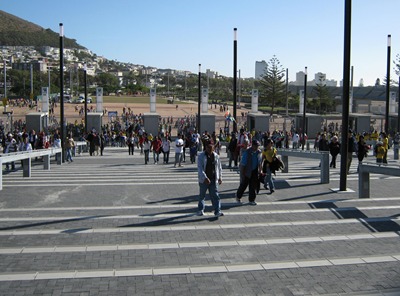
At the half-time breaks, and also during the break between the two matches, the times of the last trains out of Cape Town were shown on the two giant screens at either end of the stadium, accompanied by announcements over the public-address system. The list appeared to include every route on the Western Cape MetroRail network except perhaps Malmesbury and Worcester - there were late trains to Stellenbosch, Bellville, Wellington, Strand, Simon's Town, the Cape Flats, Kapteinsklip and Khayelitsha. The times of these "last trains" varied between 10 PM and 10:40 PM.
I went to the toilet during one of the breaks and was staggered at the sheer quantity of toilet facilities in the new stadium. The mens' toilets near where we were sitting were huge, with a long row of cubicles and many urinals. After many times having experienced the unpleasant queues for the meagre toilet facilities at Newlands cricket stadium it came as something of a relief to be able to answer the call of nature without queueing, jostling and being crowded for space.
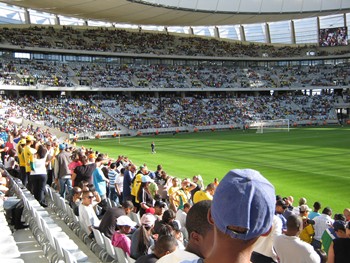
We left at about 9 PM, shortly before the end of the second match (Brazil were leading Ghana 1-0, which was also the eventual final score). Outside the stadium marshalls were directing people to the free shuttle buses but we elected to walk back to the train station along the "fan walk" - it was a balmy evening and very pleasant. There was plenty of visible security all along the route through Green Point and the city centre, a distance of about two kilometres. Crowds of people were on the streets and packing neighbourhood bars, restaurants and nightclubs, with everybody seemingly in a jovial mood - World Cup fever or just a normal Saturday night? Perhaps a bit of both ...
At the station the electronic boards informed us that we had missed the 21:10 train to Fish Hoek but that the next one was at 21:40, followed by one at 22:10 and the last one at 22:30. The station was fairly deserted at that hour but security guards were patrolling and there were a smattering of fellow football spectators also hurrying to catch their trains home.
Ticket checking at the barriers onto the platforms was thorough. Our train, one of the newer 10M3 models, left a few minutes late. Security guards moved all "MetroPlus" (the old "first class") passengers into one coach and all "Metro" (the old "third class") passengers onto another ; these guards stayed on the train all the way to Fish Hoek. We trundled south in the darkness, disgorging passengers along the way. Nobody got on the train after we left Cape Town, which was not surprizing considering that it was 10 PM on a Saturday night and usually no MetroRail trains operate on the Southern Suburbs line after 8 PM over the weekend (and not much later than that during the week). We arrived home at about 11 PM, tired but exhilarated after a thoroughly enjoyable afternoon and evening.
After experiencing this event first-hand there is absolutely no doubt in my mind that the 2010 World Cup in SA will be a superbly-run event. I can't wait for the first match in Cape Town - I'll be there, rooting for either France or Uruguay (I haven't made up my mind yet ...).
 © Paul Kilfoil, Cape Town, South Africa
© Paul Kilfoil, Cape Town, South Africa